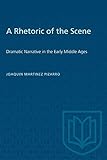A Rhetoric of the Scene : Dramatic Narrative in the Early Middle Ages / Joaquin Martinez-Pizarro.
Material type: TextSeries: HeritagePublisher: Toronto : University of Toronto Press, [1989]Copyright date: ©1989Description: 1 online resource (288 p.)Content type:
TextSeries: HeritagePublisher: Toronto : University of Toronto Press, [1989]Copyright date: ©1989Description: 1 online resource (288 p.)Content type: - 9781487580858
- 9781487579753
- 878/.0308/0923 23
- PN212
- online - DeGruyter
| Item type | Current library | Call number | URL | Status | Notes | Barcode | |
|---|---|---|---|---|---|---|---|
 eBook
eBook
|
Biblioteca "Angelicum" Pont. Univ. S.Tommaso d'Aquino Nuvola online | online - DeGruyter (Browse shelf(Opens below)) | Online access | Not for loan (Accesso limitato) | Accesso per gli utenti autorizzati / Access for authorized users | (dgr)9781487579753 |
restricted access online access with authorization star
http://purl.org/coar/access_right/c_16ec
In the course of the sixth century AD a remarkable change takes place in the form of Western literary narrative. Dramatic mimesis, which in classical and late antique narrative had always been exceptional, and therefore a mark of the importance of whatever event it was used to represent, becomes systematic. The action of a story turns into a series of scenes described by a self-effacing narrator, as if we were seeing them take place. In this study Joaquin Martinez Pizarro focuses on the scene as the characteristic minimal unit, and on its elements: dialogue, gestures, and significant objects. The scene gives to early medieval narrative an extraordinary animation and vividness. But these qualities, which would appear to entail a richly visual form of representation, are combined instead with an abstract, schematic interest. The staging of each scene is clearly subordinated to a concept or point, and no more of the action is described than this overriding purpose requires. The style, at the same time dramatic and highly conceptual, realistic yet uninterested in showing reality, is of considerable intrinsic interest, and stands in marked contrast to the form of high- and late-medieval narrative. It has been little studied because its chief monuments are not vernacular but Greek and Latin, and not fictional but historical in a board sense. Pizarro draws on such authors as Gregory of Tours, Paul the Deacon, Agnellus of Ravenna, and Notker Balbulus to analyse the elements of scenic form, referring to Byzantine narratives of the period to supplement his analysis and provide a basis for comparison.
Mode of access: Internet via World Wide Web.
In English.
Description based on online resource; title from PDF title page (publisher's Web site, viewed 01. Nov 2023)


